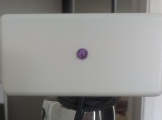Difference between revisions of "Bidirectional pass counter v.2.1"
(→Description) |
(→WiFi Setup) |
||
| Line 72: | Line 72: | ||
== WiFi Setup == | == WiFi Setup == | ||
| − | All Baozam devices use the same [[WiFi Setup]] procedure. The difference is in where the setup button is placed and how it looks. The counter ''WiFi setup'' button is inside the ''WiFi setup'' hole | + | All Baozam devices use the same [[WiFi Setup]] procedure. The difference is in where the setup button is placed and how it looks. The counter ''WiFi setup'' button is inside the ''WiFi setup'' hole above the three colored LEDs on the front of the receiver (Fig. 1 top). |
* [[WiFi Setup|Common Baozam device WiFi setup procedure]] | * [[WiFi Setup|Common Baozam device WiFi setup procedure]] | ||
Revision as of 02:04, 23 December 2016
Contents
Description
The counter consists of two modules:
- receiver - with three LEDs in the middle of the front panel, the WiFi setup hole above the three LEDs and two holes on the sides of the front panel (Fig. 1 top).
- emitter - with one LED in the middle of the front panel (Fig. 1 bottom).
Both units have a rectangular hole for the power cord at bottom (Fig. 2, rectangular recess in the bottom wall). White boxes on pictures are power cord connectors.
Specifications
| Maximum distance between emitter and receiver | 6 meters |
| IR wavelength | 940 nm |
| Modulation frequency of the IR signal | 38 kHz |
| Power supply | 5 — 24 V DC |
| Communication standard | 802.11b/g/n (WiFi) network with a password only |
| Used communication protocols | TCP / IP, TLS 1.2, HTTPS, WebSocket |
| Power Consumption | |
| emitter | no more than 100 mW |
| receiver | 1 W |
| Operating temperature range | 5°C — 40°C, with relative humidity of 80% |
| Dimensions (WxHxD) | 80mm x 40mm x 20mm |
| Hull material | ABS plastic |
| Color | grey, black |
Installation
- Connect the power cords to the modules. The polarity does not matter.
- Fix the modules on both sides of the aisle at a height of 1.20 — 1.40 meters. The receiver must be placed horizontally (to detect the direction of the input/output).
- Connect the power supply. All LEDs on the receiver should light up for 2 seconds.
- The efficiency of the emitter can be checked by using the smart-phone camera. When you look on the emitter LED from a short distance (couple of centimeters) through the smart-phone camera, LED of working emitter will be of red-blue/purple color (Fig. 3).
Receiver LEDs flashing description:
- Green LED (bottom, state indicator):
- 1 blink per 5 seconds (0.2 Hz) - normal mode
- 1 blink per second (1 Hz) - setup mode initiated by Tuner page over the Baozam cloud
- 10 blinks per second (10 Hz) - WiFi setup mode
- Yellow LED (middle, pass indicator):
- 10 blinks per second (10 Hz) - no beam from emitter
- single blink - input counted
- triple blink - output counted
- Red LED (top, errors indicator):
- Under normal conditions this led should not blink.
- If any errors detected the LED will blink all the errors circle-wise. Time distance between error blinks is one second. The pattern of blink (3Hz) means the following:
- single (1/10) - WiFi isn't connected, or 10Hz - device couldn't connect to the server
- double (2) - WiFi module is broken
- triple (3) - Device couldn't check Coordinated Universal Time
- quadruple (4) - Internal device timer does not start (timer is broken)
- quintuple (5) - Internal device timer does not work correctly (rare external high power electromagnetic pulses, water, etc)
- sextuple (6) - Device internal storage is broken
WiFi Setup
All Baozam devices use the same WiFi Setup procedure. The difference is in where the setup button is placed and how it looks. The counter WiFi setup button is inside the WiFi setup hole above the three colored LEDs on the front of the receiver (Fig. 1 top).
Setting and checking the operation of the device
All Baozam devices have common interface for tuning via the Internet. Please, read details at Device tuning via the baozam.net website page.
You should check:
If the emitter beam hits the receiver sensors (parameters left sensor & right sensor).
- Switch on sensor monitors (left sensor, right sensor). Normal values range 5 - 6.
- If the reading is less than 5, the emitter and receiver are not aligned or something breaks the beam. Adjust the alignment, clean the beam path.
- If values are greater than 7 look for the source of noise.
The direction of the entrance/exit.
- By default, the input direction is from left to right relatively to the receiver.
- Switch on monitoring parameter count_in & count_out. Break the beam ...
- Change the direction by using the Mode Control button. Use the drop-down button LEFT to RIGHT is ENTER or LEFT to RIGHT is EXIT to select the desired direction.
Important!
If you have changed any parameter, be sure to save the changes (Settings --> Save). Otherwise, when you switch the device off your settings will be lost.


